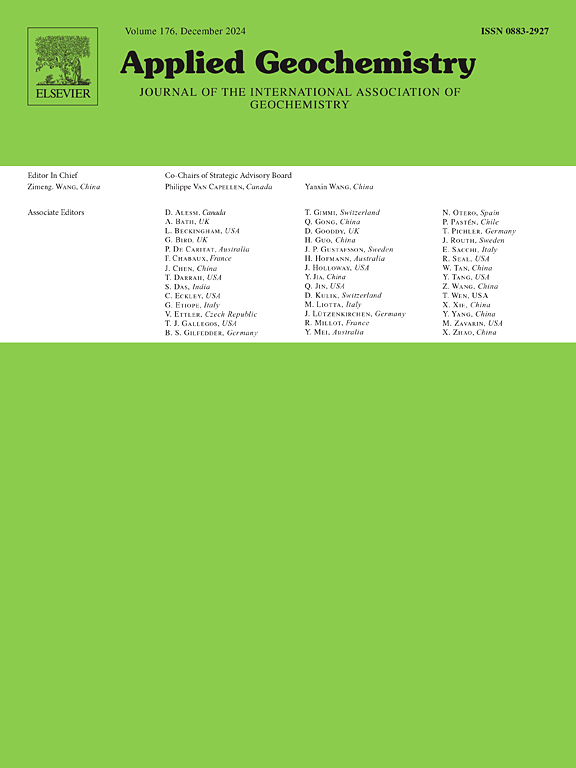Trace element partitioning between natural barite and deep anoxic groundwaters: Implications for radionuclide retention in host rocks of nuclear waste repositories
IF 3.1
3区 地球科学
Q1 GEOCHEMISTRY & GEOPHYSICS
引用次数: 0
Abstract
Safety assessments for deep geological repositories involve risk calculations for the release of radionuclides like Ra, U, Pu and trivalent actinides from the storage containers to the groundwater. The retention of radionuclides through water-mineral interaction along the groundwater flow path could be a crucial factor in case of a repository failure. Barite (BaSO4) assumes significance in this context, as it has the potential to (re)crystallize and incorporate significant quantities of radioactive elements under relevant physico-chemical conditions.
The assessment of mineral-fluid partition coefficients provides a means to evaluate the uptake potential of elements into the mineral. Usually, partition coefficients are determined under well-defined and controlled experimental conditions in laboratories. However, these results have shown discrepancies to partitioning coefficients determined from natural systems.
Furthermore, effects like diagenesis or changes in the chemical fluid parameters might lead to a secondary alteration of the phases and affecting the retention ability.
Here we investigate the incorporation of trace elements in natural barite from a borehole at 415 m depth in the Äspö Hard Rock Laboratory (Sweden). High-resolution LA-ICP-MS enables the quantitative determination of field-based partition coefficients through the integrated pixel average of selected zones in element distribution maps, combined with existing fluid concentration data. Similarities between the solid solution systems (Ra,Ba)SO4 and (Sr,Ba)SO4 allowed the combination of Sr partitioning data with density-functional theory simulations for an estimation of the partition coefficient value for Ra in natural barite. Values in the 10−2 range were determined, showing a deviation from those reported in previous experimental studies in the 10° range.
Moreover, lanthanum serves as an analogue element for the radioactive trivalent actinides. The partition coefficient values for La in natural barite were determined in the range of 10−2 and 10−1, aligning well with experimental partition coefficients. Although density functional theory simulations cannot directly convert a La partition coefficient into a partition coefficient for trivalent actinides, it is assumed that these elements exhibit comparable behavior. Besides primary growth zonation, La also exhibits strong secondary enrichment, probably resulting from groundwater mixing and late fluid-mediated element transport through connected intracrystalline pore space oriented at cleavage plane systems. Additional SIMS analysis provides insights into the temporal variation of the sulfate source at the sampling site reflecting the influence of different waters during mineral growth.
This study demonstrates a discrepancy between natural and synthetic PRa for barite and emphasizes that secondary processes significantly impact radionuclide retention in barite. Including these effects in reactive transport models will improve the reliability and applicability of integrative risk models.
天然重晶石与深层缺氧地下水之间的微量元素分配:核废料贮存库主岩中放射性核素滞留的影响
深地质处置库的安全评估涉及镭、铀、钚和三价锕系元素等放射性核素从储存容器释放到地下水的风险计算。放射性核素在地下水流动路径上通过水与矿物的相互作用而被保留下来,这可能是储存库发生故障时的一个关键因素。重晶石(BaSO4)在这方面具有重要意义,因为它有可能(重新)结晶,并在相关物理化学条件下吸收大量放射性元素。通常,分配系数是在实验室明确规定和受控的实验条件下测定的。此外,成岩作用或化学流体参数变化等效应可能会导致相的二次改变,从而影响保留能力。在此,我们研究了来自瑞典阿斯波硬岩实验室(Äspö Hard Rock Laboratory)415 米深钻孔的天然重晶石中微量元素的掺入情况。高分辨率 LA-ICP-MS 能够通过元素分布图中选定区域的综合像素平均值,结合现有的流体浓度数据,定量确定基于现场的分配系数。(Ra,Ba)SO4 和 (Sr,Ba)SO4固溶体系统之间的相似性使我们能够将 Sr 分配数据与密度函数理论模拟相结合,从而估算出天然重晶石中 Ra 的分配系数值。所确定的数值在 10-2 范围内,这与之前的实验研究中报告的 10° 范围内的数值有所偏差。此外,镧是放射性三价锕系元素的类似元素。天然重晶石中镧的分配系数值确定在 10-2 和 10-1 之间,与实验分配系数非常吻合。虽然密度泛函理论模拟不能直接将 La 的分配系数转换为三价锕系元素的分配系数,但可以推测这些元素表现出相似的行为。除了原生生长分带外,镭元素还表现出强烈的次生富集,这可能是由于地下水混合和后期流体介导的元素通过面向裂隙面系统的相连结晶内孔隙传输所致。这项研究表明重晶石的天然 PRa 与合成 PRa 之间存在差异,并强调次生过程对重晶石中放射性核素的保留有重大影响。将这些影响纳入反应迁移模型将提高综合风险模型的可靠性和适用性。
本文章由计算机程序翻译,如有差异,请以英文原文为准。
求助全文
约1分钟内获得全文
求助全文
来源期刊

Applied Geochemistry
地学-地球化学与地球物理
CiteScore
6.10
自引率
8.80%
发文量
272
审稿时长
65 days
期刊介绍:
Applied Geochemistry is an international journal devoted to publication of original research papers, rapid research communications and selected review papers in geochemistry and urban geochemistry which have some practical application to an aspect of human endeavour, such as the preservation of the environment, health, waste disposal and the search for resources. Papers on applications of inorganic, organic and isotope geochemistry and geochemical processes are therefore welcome provided they meet the main criterion. Spatial and temporal monitoring case studies are only of interest to our international readership if they present new ideas of broad application.
Topics covered include: (1) Environmental geochemistry (including natural and anthropogenic aspects, and protection and remediation strategies); (2) Hydrogeochemistry (surface and groundwater); (3) Medical (urban) geochemistry; (4) The search for energy resources (in particular unconventional oil and gas or emerging metal resources); (5) Energy exploitation (in particular geothermal energy and CCS); (6) Upgrading of energy and mineral resources where there is a direct geochemical application; and (7) Waste disposal, including nuclear waste disposal.
 求助内容:
求助内容: 应助结果提醒方式:
应助结果提醒方式:


